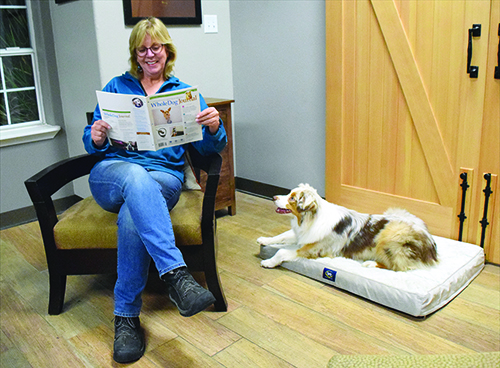
Mat training – teaching your dog to go lie down on her mat on cue, and stay there – sounds pretty simple, and in fact, it is. Not only is it a simple behavior to teach, it’s incredibly useful for a variety of different training challenges. You can use it to teach your dog polite greetings, park her calmly in public or at your training class, increase her confidence in novel situations, send her to her mat in any room in the house, give yourself a break from attention-seeking behavior, defuse tension between two dogs, move her away from a guarded resource, and much more.
It’s a bit of a wonder, then, that more humans don’t teach their dogs this simple behavior. If we’ve grabbed your attention and interest, read on to find out how you can teach your dog.
12 Steps to a “Place” Mat
A place mat is any portable rug, bed, or blanket that you can easily take with you anywhere you go with your dog, and that you will teach your dog to lie down on, on cue. The more comfortable the mat, the easier your training task will be – she will want to lie down on it.
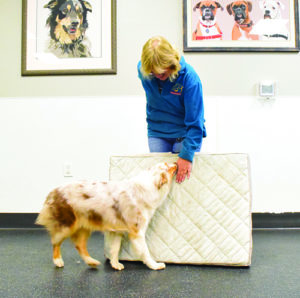
To train this behavior, it’s a good idea to start with a brand new rug, bed, or blanket – one your dog has never seen or used before. It’s not critical, but once she understands the exercise, she will recognize it as her special “go to your place” mat. Here’s how to train the behavior:
1. Hold your dog’s new mat and show great interest in it – examine it, exclaim over it, sniff it – until your dog shows interest in what you are doing.
2. Have a handy supply of medium-value treats and a supply of high-value treats ready. Be prepared to mark with a clicker or verbal marker. When your dog looks at, sniffs, or otherwise shows interest in the mat, use your marker (click! or “Yes!”) and place a medium-value treat on the mat for your dog.
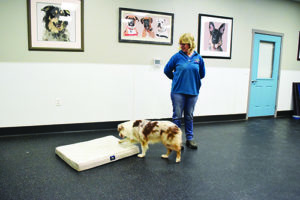
3. Continue to mark for any mat-related behaviors that your dog offers – except for grabbing it! – placing a medium-value treat on the mat each time you mark.
4. If you have used shaping in your training before and your dog is shaping-savvy, she is likely to quickly start offering a variety of behaviors. If she offers any on-the-mat behaviors (let’s call them OTMBs for short), use your marker and put a medium-value treat on the mat. But if she offers to lie down on the mat, use your marker and give her a high-value treat on the mat. Any other offered OTMBs continue to get medium-value treats.
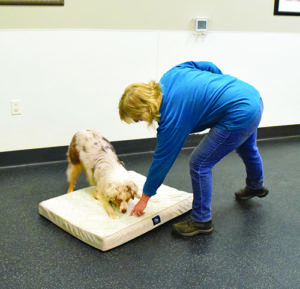
5. If your dog is not savvy about shaping, continue to mark any OTMBs, but occasionally, randomly use your “Down” cue to ask her to lay down on the mat. When she does, mark and give her a high-value treat.
6. After you have given her a cue, marked it, and given her a treat for a half-dozen or so Downs interspersed with her other offered behaviors, pause for several seconds; see if she chooses to offer you a down when she doesn’t get marked for any other behavior. If she does, mark and feed her several high-value treats. Jackpot! If she doesn’t, go back to marking any OTMBs, interspersing random downs. Deliver a medium-treat for other behaviors and a high-value treats for downs.
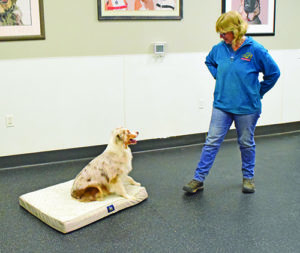
7. Repeat steps 6 and 7 until your dog begins offering downs during your pauses. Your dog is learning that any on-the-mat behavior is rewardable, but downs get the better rewards. She should soon begin offering only downs on the mat, even though other behaviors will still be getting medium rewards.
8. Now give your dog a release cue, move a few steps away from the mat, and invite your dog to follow you. When she does, stand quietly and ignore her – no marking, treating or praising. Most dogs will return to the mat to prompt you for more marks and treats. If your dog steps on to the mat, start marking and treating, again, using medium-value treats for any behavior and high-value treats for downs. Do not hold out for downs! At this juncture, you are reinforcing her for returning to the mat. Downs are great if they happen, but remember to reward any OTMBs.
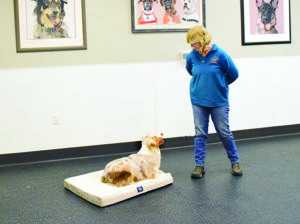
9. Repeat step 8 numerous times. Each time you give a release cue and step away from the mat, go a step or two farther away. You are teaching your dog to go to her mat from greater distances. By now she is likely returning to the mat and immediately lying down. If she is not, go back to occasionally, randomly holding out for downs. Remember, only the downs get high-value treats.
10. When your dog is consistent about quickly returning and lying down on the mat each time, you can start adding duration for the down-on-mat behavior. Increase the amount of time in small increments – just a few seconds at a time.
If at any time your dog gets off the mat before you give your release cue, pick up the mat and ignore her for a minute, then place the mat down and try again. If she gets up several times in a row, you have increased duration too quickly – go back to a shorter duration and work your way up again. (For tips on increasing the duration of the “stay” behavior, see “Stay Happy,” WDJ November 2012.)
11. When your dog will go to her mat and lie quietly on it for an extended period of time, you can add your cue. Use whatever cue you like – perhaps just the word “Place!” Practice sending her to her “Place” from increasingly longer distances, and eventually from anywhere in the house.
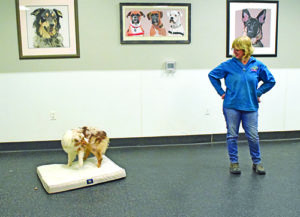
12. Finally, you need to add distractions and generalize the behavior. Practice sending your dog to her mat in the face of kindergarten-level distractions – jump once, jump twice, clap your hands…. Gradually work up to college level, where you can send her to her mat even with kids running through the house or while food is being prepared in the kitchen.
Eventually, if you keep practicing, she should be able to go to her mat on cue at the Ph.D. level – when the doorbell rings, visitors enter, or during any other exciting situation.
Depending on your dog and her level of training, you might accomplish your mat training project in just a few sessions. If your dog is still working on basic good manners or has difficulty with impulse control, it could take longer. In any case, it’s well worth the effort.
What’s your place?
You can see that there are lots of valuable applications for this simple behavior. I’m willing to bet that many of you WDJ readers have already found good uses for mat training. We’d love to see yours on our Facebook page, and maybe we’ll even print a few in a future issue. Ready, set, place!






Thank you
Extremely helpful and timely as I am training a reactionary dog who occasionally exhibits aggression. These articles , books and suggestions are helping me deal with the issues associated. Thank you all. 😊🐩🐾
Carter is 3.5 months and as a terrier mix he was hard to house train but we got there as well as sleeping thru the night. He is already trained to sit for his night treat (no lunging to get it) & taking it without grebbing. he walks on his leash easily without pulling & comes when called. The “yr place is next” right now he gets into everything reachable
I am teaching my puppy this and he has been doing well and placing, but will sometimes get excited and bite and scratch the mat. Is the appropriate action to remove the mat until he is calm?
Same! My dog wants to bite and play with anything like that and she can’t even have a dog bed! Any advice on this? Would love to mat train. We have had lots of other training successes. She is well past puppy—an 18 month old(ish) rescue GSD/husky mix
I am in the same boat…15 month old Golden Retriever who has been mat trained but has eaten holes in his mat when I have had my back turned. He also cannot have a bed in his kennel; he chewed up the last one. Yesterday I did a search looking for indestructible dog beds, lol! I would love to train him out of this but not sure how. Any ideas, anyone?
I have the same problem with our 1yr old Golden Retriever! He has ruined every dog bed that we have ever gotten for him. It’s not safe to put a mat in his crate because he tears it up and eats it! Otherwise he is very well behaved in the house. Yes, we have to always keep an eye on him but he minds very well. I would like to train him on the mat for times when company comes over though.
I never thought to show my own interest in the mat before giving it to my dog. I guess it makes sense because they love sharing. If they see it is something you like and you let them on it then it could make them feel like it’s a privilege to be on it.